Huevos for Breakfast
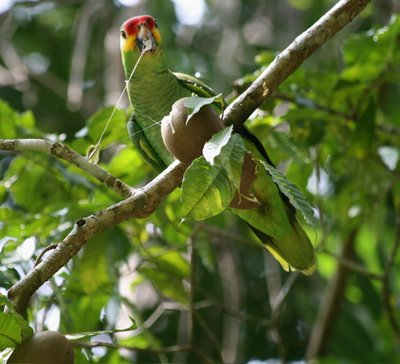 Huevos del Toro, if you're refined, and bull's balls if, like me, you're not. Named for the way it hangs in pairs, they're one of my favorite Guatemalan fruits, even though I've never, um, eaten them. They're hugely popular with birds. Last year at Tikal, I took some delightful pictures of a wild red-lored Amazon parrot making his sticky way through an unripe fruit, intent on seed piracy. Naughty parrot, you're going around the plant's divine plan for its own dispersal, tearing through unripe flesh to eat its seeds, and you're getting all gummy, too. Yes, parrot fans, this is how parrots should live--free to be themselves in all their irascible, sociable, messy glory. And yes, I tear up whenever I see them living, foraging, quarreling and flying as they were meant to.
Huevos del Toro, if you're refined, and bull's balls if, like me, you're not. Named for the way it hangs in pairs, they're one of my favorite Guatemalan fruits, even though I've never, um, eaten them. They're hugely popular with birds. Last year at Tikal, I took some delightful pictures of a wild red-lored Amazon parrot making his sticky way through an unripe fruit, intent on seed piracy. Naughty parrot, you're going around the plant's divine plan for its own dispersal, tearing through unripe flesh to eat its seeds, and you're getting all gummy, too. Yes, parrot fans, this is how parrots should live--free to be themselves in all their irascible, sociable, messy glory. And yes, I tear up whenever I see them living, foraging, quarreling and flying as they were meant to. Ah, parrots...Given time, huevos del toro fruit ripen and split open (ow!) to reveal rich orange flesh, and that's when the fun starts.
I had a blast photographing a queue of birds feeding at a newly ripe huevo del toro. First were a little troupe of red-legged honeycreepers. Female and immature honeycreepers are dull green. Sweet little birds they are, but I never photographed them without longing for an adult male in good plumage. Naturally, the dull immatures gave me terrific opportunities. I was reminded of the relative difficulty of shooting photos of white-tailed does and fawns versus trophy bucks. I have lots of doe and fawn photos. My buck photos are all distant and blurry. Here's a doe red-legged honeycreeper.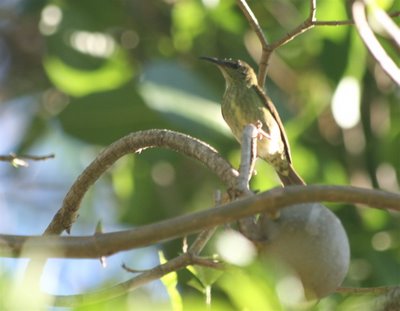 And the prize: mango-red fruit.
And the prize: mango-red fruit.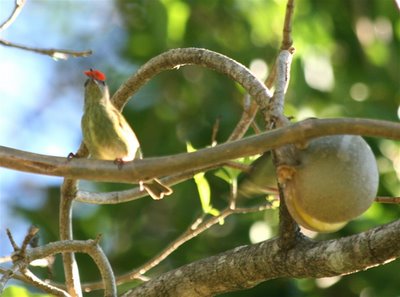
Sorry to say, the best picture I was able to get of a buck red-legged honeycreeper appears below. Oh, they are beautiful, clothed in ultramarine satin, with a glittering turquoise coronet and red legs that look as if they're made of wax or plastic. I tried, but it's a pale simulacrum of the bird. At least you can see inside the bull's ball.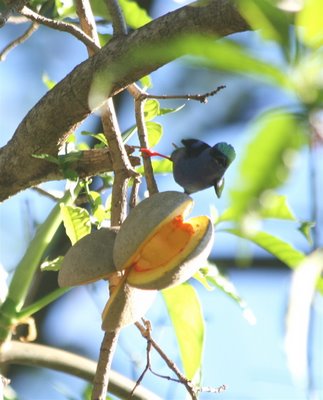
Dominant at the breakfast bar was a pair of rufous-naped wrens (Campylorhynchus rufinucha). This gorgeous big wren is in the same genus as our big, bold cactus wren, C. brunneicapillus, and I think it shows.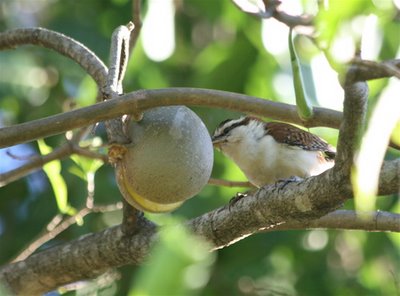
The wrens, which travel in pairs, were busy probing in the fruit, bending themselves almost double to get the sweet flesh.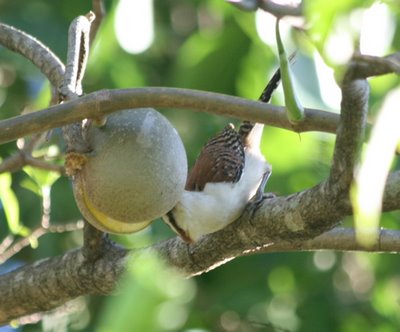
Yum!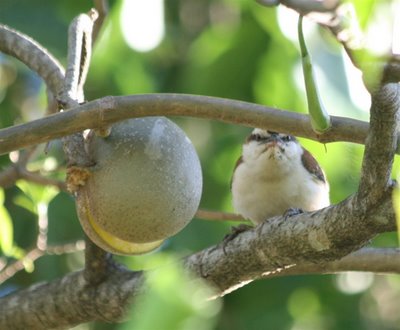 Here's the rufous nape that gives the wren its name. Tropical birds have the most prosaic common names, hard to remember and sometimes hard to divine. A bird with a glowing orange belly might be described as "slate-throated," because there's another closely related bird with a brilliant yellow belly and a yellow throat. So this gorgeous wren's most distinctive characteristic in contrast to its congeners turns out to be its rufous nape. Which results in a common name that's eminently forgettable. That's what happens when you have hundreds upon hundreds of similar-looking birds to name.
Here's the rufous nape that gives the wren its name. Tropical birds have the most prosaic common names, hard to remember and sometimes hard to divine. A bird with a glowing orange belly might be described as "slate-throated," because there's another closely related bird with a brilliant yellow belly and a yellow throat. So this gorgeous wren's most distinctive characteristic in contrast to its congeners turns out to be its rufous nape. Which results in a common name that's eminently forgettable. That's what happens when you have hundreds upon hundreds of similar-looking birds to name.
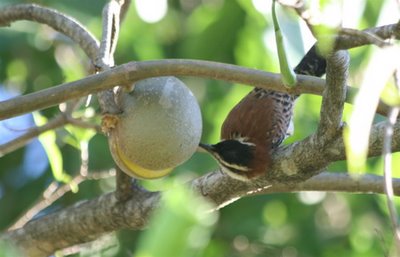 With each bit of fruit secured, the foraging bird deserted its post and flew off. I like this picture, taken just before the wren departed with its prize. I could have stood beneath this tree all day, watching the parade, but I had to report back to the mess hall for my breakfast, which involved huevos revueltos y frijoles refritos.
With each bit of fruit secured, the foraging bird deserted its post and flew off. I like this picture, taken just before the wren departed with its prize. I could have stood beneath this tree all day, watching the parade, but I had to report back to the mess hall for my breakfast, which involved huevos revueltos y frijoles refritos.
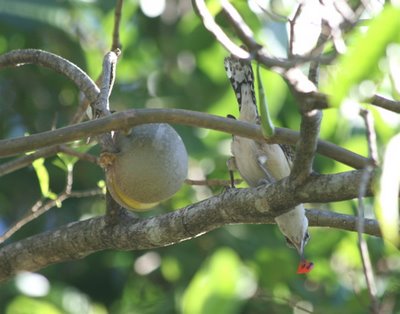 Thanks to all of you who checked out the NPR parrot commentary and emailed it to friends. It's Sunday, and it's still a-settin' on NPR's list at #1 Most Emailed, since sometime Friday afternoon. I suspect I have you, and the peculiar appeal of pets and parrots, to thank for that.
Thanks to all of you who checked out the NPR parrot commentary and emailed it to friends. It's Sunday, and it's still a-settin' on NPR's list at #1 Most Emailed, since sometime Friday afternoon. I suspect I have you, and the peculiar appeal of pets and parrots, to thank for that.
I had a blast photographing a queue of birds feeding at a newly ripe huevo del toro. First were a little troupe of red-legged honeycreepers. Female and immature honeycreepers are dull green. Sweet little birds they are, but I never photographed them without longing for an adult male in good plumage. Naturally, the dull immatures gave me terrific opportunities. I was reminded of the relative difficulty of shooting photos of white-tailed does and fawns versus trophy bucks. I have lots of doe and fawn photos. My buck photos are all distant and blurry. Here's a doe red-legged honeycreeper.
 And the prize: mango-red fruit.
And the prize: mango-red fruit.
Sorry to say, the best picture I was able to get of a buck red-legged honeycreeper appears below. Oh, they are beautiful, clothed in ultramarine satin, with a glittering turquoise coronet and red legs that look as if they're made of wax or plastic. I tried, but it's a pale simulacrum of the bird. At least you can see inside the bull's ball.

Dominant at the breakfast bar was a pair of rufous-naped wrens (Campylorhynchus rufinucha). This gorgeous big wren is in the same genus as our big, bold cactus wren, C. brunneicapillus, and I think it shows.

The wrens, which travel in pairs, were busy probing in the fruit, bending themselves almost double to get the sweet flesh.

Yum!
 Here's the rufous nape that gives the wren its name. Tropical birds have the most prosaic common names, hard to remember and sometimes hard to divine. A bird with a glowing orange belly might be described as "slate-throated," because there's another closely related bird with a brilliant yellow belly and a yellow throat. So this gorgeous wren's most distinctive characteristic in contrast to its congeners turns out to be its rufous nape. Which results in a common name that's eminently forgettable. That's what happens when you have hundreds upon hundreds of similar-looking birds to name.
Here's the rufous nape that gives the wren its name. Tropical birds have the most prosaic common names, hard to remember and sometimes hard to divine. A bird with a glowing orange belly might be described as "slate-throated," because there's another closely related bird with a brilliant yellow belly and a yellow throat. So this gorgeous wren's most distinctive characteristic in contrast to its congeners turns out to be its rufous nape. Which results in a common name that's eminently forgettable. That's what happens when you have hundreds upon hundreds of similar-looking birds to name. With each bit of fruit secured, the foraging bird deserted its post and flew off. I like this picture, taken just before the wren departed with its prize. I could have stood beneath this tree all day, watching the parade, but I had to report back to the mess hall for my breakfast, which involved huevos revueltos y frijoles refritos.
With each bit of fruit secured, the foraging bird deserted its post and flew off. I like this picture, taken just before the wren departed with its prize. I could have stood beneath this tree all day, watching the parade, but I had to report back to the mess hall for my breakfast, which involved huevos revueltos y frijoles refritos. Thanks to all of you who checked out the NPR parrot commentary and emailed it to friends. It's Sunday, and it's still a-settin' on NPR's list at #1 Most Emailed, since sometime Friday afternoon. I suspect I have you, and the peculiar appeal of pets and parrots, to thank for that.
Thanks to all of you who checked out the NPR parrot commentary and emailed it to friends. It's Sunday, and it's still a-settin' on NPR's list at #1 Most Emailed, since sometime Friday afternoon. I suspect I have you, and the peculiar appeal of pets and parrots, to thank for that. And me without my big, foam, "We're # 1" fake finger. Where do you get those things, anyway? Stadiums? I would like to get one, so I can dance unseen around the meadow, pointing it at the sky and yapping like a coyote.
I would like to get one, so I can dance unseen around the meadow, pointing it at the sky and yapping like a coyote.
 I would like to get one, so I can dance unseen around the meadow, pointing it at the sky and yapping like a coyote.
I would like to get one, so I can dance unseen around the meadow, pointing it at the sky and yapping like a coyote.Labels: bull's balls, Huevos del toro, Los Tarrales, red-legged honeycreeper, red-lored Amazon, rufous-naped wren





